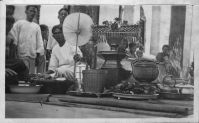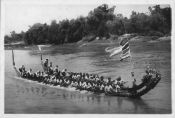Vers la photothèque de l'EFEO To the EFEO photo library Đến thư viện ảnh EFEO
-
Fonds patrimoniaux de l'EFEO
EFEO heritage collection
>> read morePhông ảnh di sản của EFEO>> đọc thêm
-
Fonds Sheppard Ferguson
Sheppard Ferguson's collection
>> read morePhông ảnh của Sheppard Ferguson>> đọc thêm
-
Chine - Tibet
China - Tibet
>> read moreTrung quốc - Tây Tạng>> đọc thêm
-
Thaïlande
Thailand
>> read moreThái Lan>> đọc thêm
-
Indonésie
Indonesia
>> read moreIndonesia>> đọc thêm
-
Vietnam
Vietnam
>> read moreViệt Nam>> đọc thêm
-
Cambodge
Cambodia
>> read moreCampuchia>> đọc thêm
-
Inde - Sri Lanka
India - Sri Lanka
>> read moreẤn Độ - Sri Lanka>> đọc thêm
-
Laos
Laos
>> read moreLào>> đọc thêm
Thaïlande
Thailand
TháiLan
Ce fonds n’est pas celui dont le volume est le plus important, notamment si on le compare à celui du Vietnam ou du Cambodge. En effet, au niveau institutionnel, l’EFEO n’a eu qu’une présence limitée au Siam (devenu en 1939 la Thaïlande) et n’a donc pas bénéficié au même titre du regard expert des chargés de mission, professeurs, érudits, chercheurs ou photographes professionnels qui s’installèrent nombreux dans les autres pays. Cela dit, George Cœdès -directeur et membre de l’EFEO de 1911 à 1947- et quelques autres grands savants français ont été des voyageurs avertis ou des résidents connus et appréciés de ce royaume. Ces experts travaillèrent avec des institutions siamoises, laissant un grand nombre de documents aux archives du royaume.
Quoique modeste, la collection de l’EFEO est précieuse car le Siam n’a sauvegardé que peu de documents ayant pu résister aux atteintes du climat tropical (la conservation préventive n’est apparue dans les bibliothèques de Thaïlande que vers les années 1980 avec la généralisation de la climatisation et l’apparition des déshumidificateurs). Un bon nombre des plus belles photos siamoises du début du xxème siècle ne sont connues que par des copies.
Ces clichés doivent être perçus comme des documents de travail, des outils scientifiques au service des arts, de l’anthropologie ou de l’histoire.
This collection is not the one with the largest volume, especially when compared to that of Vietnam or Cambodia. Indeed, at the institutional level, the EFEO had only a limited presence in Siam (which became Thailand in 1939) and therefore did not benefit in the same way from the expert eye of the chargés de mission, professors, scholars, researchers or professional photographers who settled in large numbers in the other countries. That said, George Cœdès -director and member of the EFEO from 1911 to 1947- and a few other great French scholars were well-informed travelers or well-known and appreciated residents of this kingdom. These experts worked with Siamese institutions, leaving a large number of documents in the kingdom's archives.
Although modest, the EFEO's collection is valuable because Siam saved few documents that could withstand the ravages of the tropical climate (preventive conservation did not appear in Thai libraries until the 1980s with the generalization of air conditioning and the appearance of dehumidifiers). Many of the most beautiful Siamese photographs of the beginning of the 20th century are known only through copies.
These photographs should be seen as working documents, scientific tools for the arts, anthropology or history.
Phông này không phải là bộ sưu tập lớn nhất, đặc biệt là khi so sánh với phông ảnh về Việt Nam hay Campuchia. Về thể chế, EFEO không nhiều nghiên cứu ở Xiêm (năm 1939 đổi tên là Thái Lan) và do đó không có nhiều chuyên gia, giáo sư, học giả, nhà nghiên cứu hoặc nhiếp ảnh gia chuyên nghiệp như ở các nước khác. Tuy nhiên, George Cœdès - giám đốc và thành viên của EFEO từ năm 1911 đến năm 1947- cùng một số học giả lớn của Pháp là những du khách có nhiều hiểu biết hoặc là cư dân được vương quốc này biết đến và đánh giá cao. Những chuyên gia này đã làm việc với các viện của Xiêm và để lại một khối tài liệu di sản lớn trong kho lưu trữ của vương quốc này.
Mặc dù không nhiều nhưng bộ sưu tập của EFEO vẫn rất quý vì Xiêm chỉ lưu trữ được một số tài liệu có thể chịu được điều kiện khí hậu nhiệt đới (các thư viện của Thái Lan chỉ áp dụng biện pháp bảo quản bằng máy điều hòa và máy hút ẩm vào những năm 1980). Nhiều bức ảnh đẹp nhất về Xiêm đầu thế kỷ 20 chỉ được biết đến qua các bản sao.
Những bức ảnh này được coi như là tài liệu nghiên cứu, công cụ khoa học nghiên cứu nghệ thuật, nhân học hay lịch sử.



 Copyright© WebMuseo 2023 - 2024
Copyright© WebMuseo 2023 - 2024